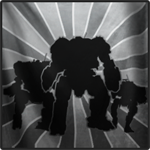What does this mean? At face value this means how long it takes to make remove a player from the game, right? But what are we really meaning when we say this? I would argue that most of us are thinking of TTK as measure of how long we are an effective participant in the match.
No one really enjoys romping around with no torsos and maybe a head laser to be obnoxious with. It is at that point that most players become kamikazes and generally try to get in the other team's way, seeking destruction.
No, Time To Kill is really about absorbing firepower while still being able to return fire. It is how long a player is effective.
Which takes us to the combination of :
Structure, Armor, & Agility Quirks
It is through these quirks that we directly impact the amount of firepower a mech can receive before becoming ineffective. Each of these serves a role :
- Structure - increases the amount of firepower it takes to render a section of a mech destroyed. DOES NOT PROTECT WEAPONS OR AMMO
- Armor - increases the amount of firepower it takes to reveal Structure. Does protect weapons and ammo.
- Agility - increases the players ability to spread incoming firepower across many sections of the mech, rewarding higher skill players with longer gamplay.
Structure, which does not protect weapons or ammo, really means that your mech can be functional longer, but ineffective. Who wants to pilot a weaponless mech? Is that fun? Mechs which carry large weapons especially receive very little benefit from Structure. With the armor stripped and critical rolls happening, we are well aware what happens to these weapons. They are destroyed and while that section of the mech may persist, the overall effectiveness is decreased as if the section had been destroyed.
The only time structure quirks are worth it are on the legs. Since you cannot destroy actuators, +Structure directly keeps your mech mobile for longer.
Armor, which does provide protection for your weapons and ammo is the most direct way to improve how much firepower a mech can absorb. No surprise, right?. We saw this applied to the HGN-732b, CTF-0XP, & BLR-2C. Although on the PTS these mechs no longer have armor bonuses.
If you want a variant to absorb more punishment, don't dance around the issue. Give them big armor bonuses. Give the player the option of having more than standard armor with the bonus, or saving some weight while keeping the "standard" values (by subtracting the +Armor amount from the applied amount in the MechLab).
But it's not just about armor.
Agility, specifically torso twist, is the second most important part of making a mech more effective for longer. It's no secret, twisting under fire spreads the damage. Combining good Torso Twist range and speed with big armor means a mech can seemingly take great punishment while remaining in the fight longer. The HGN-732b represents this today. Agility should be used to as a emphasis on +Armor.
Summary
When we say "Time To Kill", we really mean "How Long We Are Effective".
Outside of legs, +Structure does little to extend the effectiveness of a mech through a match. It, instead, increases the likelihood that you'll be disarmed while still mobile. Stop using +Structure to make mechs "tankier".
+Armor directly extends a mech's effective time in-match. Use this instead of +Structure to extend longevity.
+Agility rewards player skill and emphasizes a mech's +Armor bonuses. Use this as a method to emphasize +Armor bonuses.
*This is purely meant to discuss how Structure, Armor, & Agility affect how long a mech is effective in the game. It is understood that other methods exist through reducing how much firepower is available (weapon quirks) and that players will not shoot what they are not aware of (infotech quirks).
Edited by LCRacerX, 14 September 2015 - 10:04 AM.




















